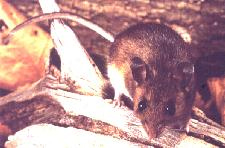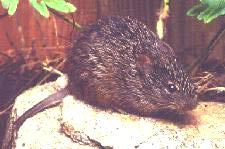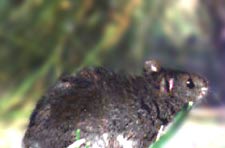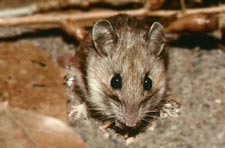|
Rodents That Carry the Types of
Hantavirus Which Cause HPS in the United States:
 The
Deer Mouse (Peromyscus maniculatus) is a deceptively
cute animal, with big eyes and big ears. Its head and body are normally
about 2 - 3 inches long, and the tail adds another 2 - 3 inches
in length. You may see it in a variety of colors, from gray to reddish
brown, depending on its age. The underbelly is always white and
the tail has sharply defined white sides. The deer mouse is found
almost everywhere in North America. Usually, the deer mouse likes
woodlands, but also turns up in desert areas. The
Deer Mouse (Peromyscus maniculatus) is a deceptively
cute animal, with big eyes and big ears. Its head and body are normally
about 2 - 3 inches long, and the tail adds another 2 - 3 inches
in length. You may see it in a variety of colors, from gray to reddish
brown, depending on its age. The underbelly is always white and
the tail has sharply defined white sides. The deer mouse is found
almost everywhere in North America. Usually, the deer mouse likes
woodlands, but also turns up in desert areas.
View map showing where deer mice live
in North America.
 The Cotton Rat (Sigmodon hispidus),
which you'll find in the southeastern United States (and way down
into Central and South America), has a bigger body than the deer mouse—head
and body about 5 - 7 inches, and another 3 - 4 inches for the tail.
The hair is longer and coarser, of a grayish brown color, even grayish
black. The cotton rat prefers overgrown areas with shrubs and tall
grasses. The Cotton Rat (Sigmodon hispidus),
which you'll find in the southeastern United States (and way down
into Central and South America), has a bigger body than the deer mouse—head
and body about 5 - 7 inches, and another 3 - 4 inches for the tail.
The hair is longer and coarser, of a grayish brown color, even grayish
black. The cotton rat prefers overgrown areas with shrubs and tall
grasses.
View map showing where cotton rats
live in North America.
 The
Rice Rat (Oryzomys palustris) is slightly smaller
than the cotton rat, having a head and body 5 - 6 inches long, plus
a very long, 4- to 7-inch tail. Rice rats sport short, soft, grayish
brown fur on top, and gray or tawny underbellies. Their feet are
whitish. As you might expect from the name, this rat likes marshy
areas and is semiaquatic. It's found in the southeastern United
States and in Central America. The
Rice Rat (Oryzomys palustris) is slightly smaller
than the cotton rat, having a head and body 5 - 6 inches long, plus
a very long, 4- to 7-inch tail. Rice rats sport short, soft, grayish
brown fur on top, and gray or tawny underbellies. Their feet are
whitish. As you might expect from the name, this rat likes marshy
areas and is semiaquatic. It's found in the southeastern United
States and in Central America.
View map showing where rice rats
live in North America.
 The White-footed Mouse (Peromyscus
leucopus) is hard to distinguish from the deer mouse. The head
and body together are about four inches long. Note that its tail
is normally shorter than its body (about 2 - 4 inches long). Topside,
its fur ranges from pale brown to reddish brown, while its underside
and feet are white. The white-footed mouse is found through southern
New England, the Mid-Atlantic and southern states, the midwestern
and western states, and Mexico. It prefers wooded and brushy areas,
although sometimes it will live in more open ground. The White-footed Mouse (Peromyscus
leucopus) is hard to distinguish from the deer mouse. The head
and body together are about four inches long. Note that its tail
is normally shorter than its body (about 2 - 4 inches long). Topside,
its fur ranges from pale brown to reddish brown, while its underside
and feet are white. The white-footed mouse is found through southern
New England, the Mid-Atlantic and southern states, the midwestern
and western states, and Mexico. It prefers wooded and brushy areas,
although sometimes it will live in more open ground.
View map showing where white-footed
mice live in North America.
Both the deer mouse and the cotton rat usually live in rural areas,
but can also be found in cities when conditions are right, such
as easy availability of food, water and shelter.
Other Rodents May Also Carry Hantavirus
Other rodents carry strains of hantavirus that cause HPS, but they have not yet been
identified. In addition, other rodent species may play host to other types of hantaviruses
that cause a different type of infection, hemorrhagic fever with renal syndrome, or HFRS.
Also see the definition of hantaviruses for more information.
It is wise, therefore, to avoid close contact with rodents in general.
|

 National
Center for Infectious Diseases
National
Center for Infectious Diseases National
Center for Infectious Diseases
National
Center for Infectious Diseases